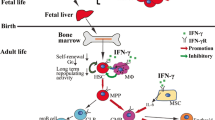Abstract
The exact mechanism of the beneficial therapeutic action of interferon-a (IFN-α) in B-cell-lineage malignancies has not been adequately explained. Here we report on the differential effect of IFN-α2b on non-malignant B cells of umbilical cord blood and leukemic B-cell lines JY, BL-41 and BCBL-1. Leukemic cell proliferation was characterized by colony assay, whereas apoptosis was investigated by flow cytometry of propidium iodide-stained cells. The degree of differentiation was evaluated by measuring the expression level of Fcγ receptor-II (FcγRII) labeled with anti-CD32-FITC monoclonal antibody using flow cytometry. IFN-α protected umbilical cord blood CD19-positive B lymphocytes from apoptotic cell death in vitro. IFN-α significantly decreased colony formation of all three cell lines, and in contrast to normal cells, induced apoptosis in JY and BL-41 and excessive necrosis in HHV-8 infected BCBL-1 cells. FcγRII was upregulated both in normal and in leukemic B cells as indicated by an increase both in the proportion of CD32-positive cells and the mean fluorescence intensity. From our results it seems that antiproliferative, apoptotic and differentiative effects of IFN-a are interrelated but distinct cellular events, which are differentially regulated in normal, leukemic and virus-infected cells of the B-cell lineage. (Pathology Oncology Research Vol 12, No 3, 159–163)
Similar content being viewed by others
Abbreviations
- FcγRII:
-
type II receptor for the constant fragment of immunoglobulin
- G, FITC:
-
fluorescein-isothiocyanate
- GM-CSF:
-
granulocytemacrophage colony-stimulating factor
- HHV-8:
-
Human Herpesvirus 8
- IFN-α:
-
interferon-alpha
- IFN-γ:
-
interferon-gamma
- IRF:
-
interferon regulatory factor
- MFI:
-
mean fluorescence intensity
- MNC:
-
mononuclear cell
- PE:
-
phycoerythrin
- SCF:
-
stem cell factor(c-kit ligand)
References
Balmelli C, Vincent IE, Rau H et al: Fc gamma RII-dependent sensitisation of natural interferon-producing cells for viral infection and interferon-alpha responses. Eur J Immunol 35: 2406–2415, 2005
BenkőI, Kovács P, Szegedi I, et al: Effect of myelotropic and pleiotropic cytokines on colony formation by blast cells of children with acute lymphoblastic leukemia. N-S Arch Pharmacol 363: 499–508, 2001
D’Agostino G, Arico E, Santodonato L et al: Type I consensus IFN (IFN-con1) gene transfer into KSHV/HHV-8-infected BCBL-1 cells causes inhibition of viral lytic cycle activation via induction of apoptosis and abrogates tumorigenicity in SCID mice. J Interferon Cytokine Res 19: 1305–1316, 1999
Heslop HE, Hoffbrand AV: Interferons in haematological malignancy. Recent Adv Haemat7: 131–148, 1992
Jewell AP: Interferon-alpha, bcl-2 expression and apoptosis in B-cell chronic lymphocytic leukemia. Leuk Lymphoma 21: 43–47, 1996
Kiss C: Interferons in pediatric oncology: end of the beginning or beginning of the end? Med Pediatr Oncol 30: 364–366, 1998
Kiss C, Surrey S, Schreiber AD et al: Human c-kit ligand (stem cell factor) induces platelet Fc receptor expression in megakaryocytic cells. Exp Hematol 24: 1232–1237, 1996
Martinez-Lostao L, Briones J, Forne I et al: Role of the STAT 1 pathway in apoptosis induced by fludarabine and JAK kinase inhibitors in B-cell chronic lymphocytic leukemia. Leuk Lymphoma 46: 435–442, 2005
McSweeney EN, Giles FJ, Worman CP et al: Recombinant alpha 2a interferon therapy in the treatment of patients with early stage B chronic lymphatic leukaemia. Br J Haemat 85: 77–83, 1993
Mikala G, Xie J, Berencsi G, Kiss C et al: Human herpesvirus 8 in hematologic diseases. Pathol Oncol Res 5: 73–79, 1999
Miyauchi J, Kelleher CA, Yang YC et al: The effects of three recombinant growth factors, IL-3, GM-CSF, and G-CSF on the blast cells of acute myeloblastic leukemia maintained in shortterm suspension culture. Blood 70: 657–663, 1987
Pearse RN, Feinman R, Shuai K et al: Interferon g-induced transcription of the high-affinity Fc receptor for IgG requires assembly of a complex that induces the 91-kDa subunit of transcription factor ISGF3. Proc Natl Acad Sci USA 90: 4314–4318, 1993
Picchio GR, Sabbe RE, Gulizia RJ et al: The KSHV/HHV8-infected BCBL-1 lymphoma line causes tumors in SCID mice but fails to transmit virus to a human peripheral blood mononuclear cell graft. Virology 238: 22–29, 1997
Pouge SL, Preston BT, Stalder J et al: The receptor for type I IFNs is highly expressed on peripheral blood B cells and monocytes and mediates a distinct profile of differentiation and activation of these cells. J Interferon Cytokine Res 24: 131–139, 2004
Pozharskaya VP, Weakland LL, Offermann MK: Inhibition of infectious human herpesvirus 8 production by gamma interferon and alpha interferon in BCBL-1 cells. J Gen Virol 85: 2779–2787, 2004
Renne R, Zhong W, Herndier B et al: Lytic growth of Kaposi’s sarcoma-associated herpesvirus (Human herpesvirus 8) in culture. Nat Med 2: 342–346, 1996
Santavenere E, Di Pietro R, Centurione MA et al: Synergistic regulatory effects of TNF alpha, IL-1 alpha and IFN alpha on the growth and differentiation of Daudi lymphoma cells. Cell Biol Int 20: 335–338, 1996
Sármay G, Koncz G, Gergely J: Human type II Fcγ receptors inhibit B cell activation by interacting with the p21s-dependent pathway. J Biol Chem 271: 30499–30504, 1996
SzöllŐsi J, Horejsi V,Bene L et al: Supramolecular complexes of MHC class I, MHC class II, CD20, and tetraspan molecules (CD53, CD81, and CD82) at the surface of a B cell line JY. J Immunol 157: 2939–2946, 1996
Zimring JC, Goodburn S, Offerman MK: Human herpesvirus encodes an interferon regulatory factor (IRF) homolog that represses IRF-1 mediated transcription. J Virol 72: 701–707, 1998
Author information
Authors and Affiliations
Corresponding author
Additional information
I. Szegedi and C. Kiss contributed equally to this publication.
Rights and permissions
About this article
Cite this article
Szegedi, I., Kiss, C., Karászi, É. et al. Differential regulation of umbilical cord blood and leukemic B cells by interferon-alpha (IFN-α): Observations in cultured cells. Pathol. Oncol. Res. 12, 159–163 (2006). https://doi.org/10.1007/BF02893363
Received:
Accepted:
Issue Date:
DOI: https://doi.org/10.1007/BF02893363




